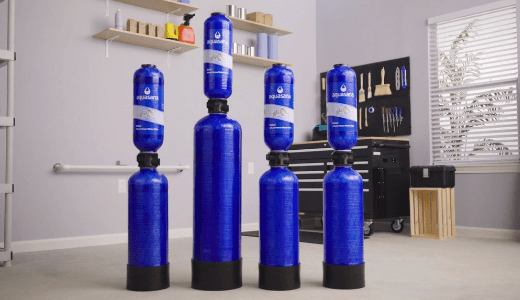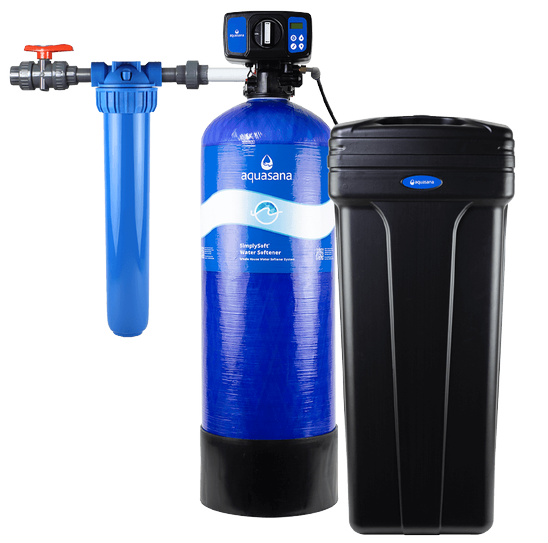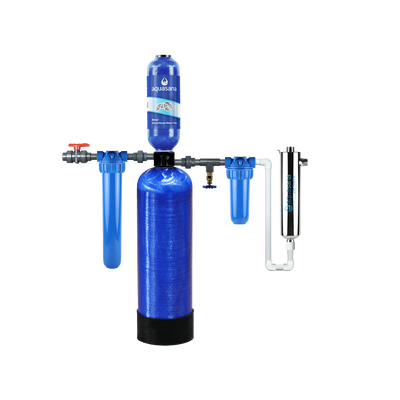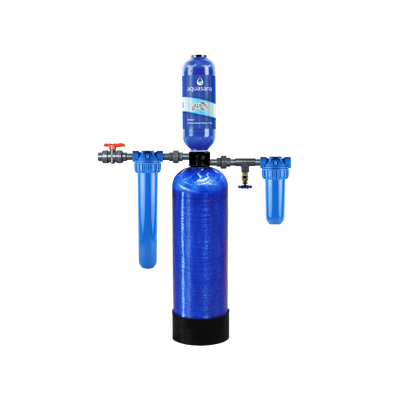2. Activated carbon filters
Activated carbon filters are the next most popular home water filter, if not the most popular. Activated carbon comes from natural materials like wood, coconut, and charcoal. When water passes through this part of your whole house water filter system, it absorbs chemicals out of the water, releasing the clean H2O back to you.
Granular activated carbon (GAC) filters are more commonly found in whole house filter systems than their counterparts, activated block filters. GAC filters contain loose carbon particles rather than bonded “block” filters, so they are much more efficient and work well with high water pressure.
Pros
- Improves taste
- Improves smell
- Removes chemicals like chlorine
- Relatively affordable
Cons
- Doesn’t remove large particles like metal
3. Catalytic carbon filters
Catalytic carbon filters work by taking the basic process for activated carbon filtering but adding gas processing at high temperatures. When this occurs, the filter absorbs contaminants and releases the filtered water.
The biggest contaminant treated by catalytic carbon filters is chloramine, a more resolute disinfectant than chlorine. Unfortunately for homes, this means it’s harder to remove.
Pros
- Removes chloramines
Cons
- Doesn’t remove chlorine as well
- Most heavy metals unaffected
- Can be more expensive

4. KDF Copper-Zinc filters
Kinetic Degradation Fluxion filters, or KDF filters, use copper and zinc to support the other components of your home water filtration system. They control the release of microorganisms into your water, like algae. A KDF-55 or KDF-85 filter may be the final step for some whole house systems.
Pros
- Inhibits bacteria and algae growth
- Improves taste and smell
- Extends the life of the system
Cons
- Doesn’t fully remove biomaterials
5. UV filters
UV filters, or UV purifiers, do not use materials to remove particles from your water. Therefore, they aren’t the best option for a standalone water filter. UV filters use ultraviolet light to eliminate dangerous microorganisms. A UV filter can protect you and your family from E Coli, giardia, and other bacteria and fungi that can make you very sick by literally changing the organism’s DNA. These filters are often sold as optional add-ons, but may be a necessity for people who rely on private well water.
Pros
- Sterilizes up to 99.99% of bacteria and viruses and 99% of cysts
- Annual lamp replacement is easy to accomplish and maintain
- No chemicals or particles used
Cons
- Must be connected to a power source at all times
- Doesn’t remove organic particles or chemical contaminants
6. Softeners and conditioners
Water softeners and conditioners are not traditional filters. Rather, they are used to tackle hard water-causing minerals like magnesium and calcium. These particles do not typically cause health issues, but they can wreak havoc on your home’s pipes and appliances if you live in an area with hard water. Softeners and conditioners work in different ways to address hard water.
- Softeners: Use ion exchange to tackle hardness-causing minerals to deliver soft, scale-free, and spotless water throughout your home. These systems require the use of salt and electricity and can handle truly hard water.
- Salt-Free Conditioners: Use a scale control media to attract mineral ions, then neutralize them by forming small crystals that are harmless. Salt-free conditioners are considered better for the environment because they do not require electricity or produce wastewater. However, these systems are best suited for water with hardness below 15 grains per gallon.
A softener or conditioner may not be necessary if you don’t have hard water, but can still improve water quality regardless. These are typically sold as optional add-ons, though you may also be able to use a softener or conditioner without a separate whole house system if hard water is your only concern.
Pros
- Prevents scale build-up by addressing hard water minerals
- Protects your home’s pipes
- Extends the life of your appliances
- Improves water texture
- Improves laundry, meaning cleaner clothes and less damage after a wash
- Cleaner dishes, without streaks
Cons
- Doesn’t filter out chemical contaminants
- Can be expensive
WATER SOFTENERS
SimplySoft® 60,000 Grain Softener
Reduces minerals that cause hard water, providing softer, scale-free water from every tap in your home.

7. Calcite filters
Calcite filters are also known as acid neutralizers and work to balance your water’s pH levels. It does this by running the water through natural minerals to bring the pH balance up, closer to a more neutral or alkaline figure. The minerals used are magnesium oxide and calcium carbonate. Unlike the other filters on this list, a calcite filter does not filter out any particles, materials, or microorganisms.
Pros
- Uses natural minerals
- Makes acidic water more basic for improved taste
Cons
- Doesn’t really filter “out” anything, rather, changes the composition of your water to be more gentle
8. Reverse osmosis filters
Reverse osmosis filters are typically the most expensive, but this is because they are the “one-stop-shop” of all water filter options. Reverse osmosis filters work by pushing water through a semi-permeable membrane at a high pressure. As water passes through, contaminants are left behind and only clean water makes it to the other side.
These filters are typically considered the most effective filtration method, and in some cases they can actually remove healthy minerals which lowers the health and negatively affects the taste of your water. As a result, you may want to look for a system with a remineralizer that restores healthy minerals lost in the RO process. Additionally, you may find that a whole house RO system isn’t worth the cost, and may be better served with an under sink RO system in the place where you get drinking water from most often like the kitchen.
Pros
- Offers the most powerful form of filtration
- Provides the best water for cooking and drinking
Cons
- Expensive
- Sometimes removes healthy minerals, reducing the health and negatively affecting the taste of your water
- Some systems create wastewater
What type of whole house filter should you buy?
Now that you have a better idea of what each type of whole house filter does, it’s time to choose a system. Consider the contaminants in your area and what stages of filtration you’ll need, then use that information to find appropriate systems. If you aren’t sure where to start, check out our whole house water filters, featuring several stages of filtration and optional add-ons to enhance performance and improve your water quality.


